400238 Healthcare Policy Analysis: Aboriginal Health in Australia
VerifiedAdded on 2022/11/13
|16
|4101
|67
Report
AI Summary
This report provides a detailed analysis of healthcare policies impacting Aboriginal and Torres Strait Islander people in Australia. It begins with an introduction that outlines the significance of the health disparities faced by these communities, emphasizing the historical neglect and the multifaceted nature of health, encompassing social, emotional, and cultural well-being. The report then delves into a policy analysis, examining the National Aboriginal and Torres Strait Islander Health Plan 2013-2023, and its framework for addressing health inequalities. It formulates the problem by highlighting the lower health status and higher mortality rates within the Aboriginal population, exploring the interconnected factors such as socio-economic inequalities, behavioral risks, and lack of access to healthcare. The report uses social, environmental, and legal frameworks to analyze the policy, considering community impact, interest groups, social justice principles, environmental factors, and relevant legislation. It critically discusses the cultural and social determinants of health, emphasizing the need for comprehensive strategies to address health inequalities. The report demonstrates a clear understanding of the policy issues, providing evidence-based analysis and proposing a solution to address the disparities.
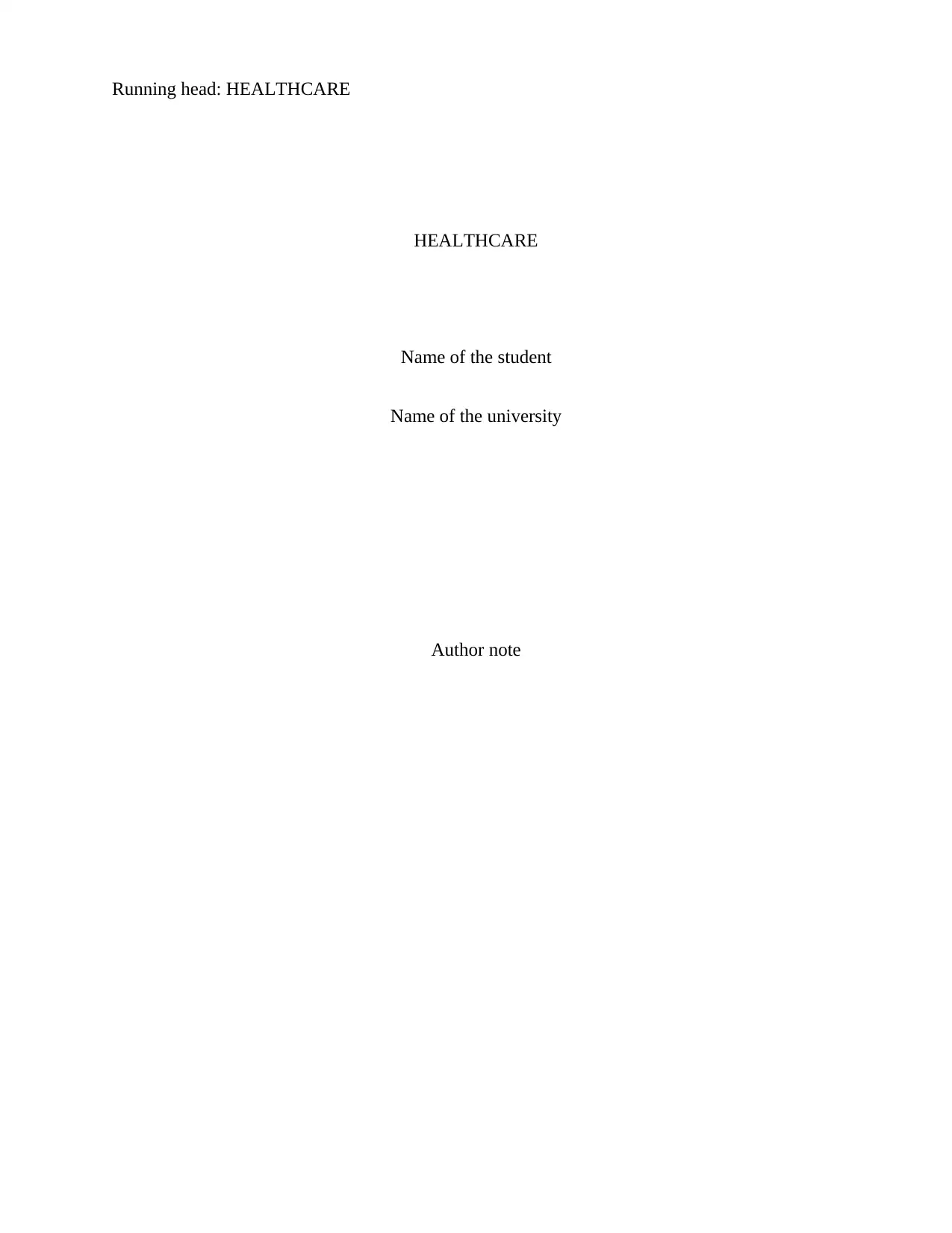
Running head: HEALTHCARE
HEALTHCARE
Name of the student
Name of the university
Author note
HEALTHCARE
Name of the student
Name of the university
Author note
Paraphrase This Document
Need a fresh take? Get an instant paraphrase of this document with our AI Paraphraser
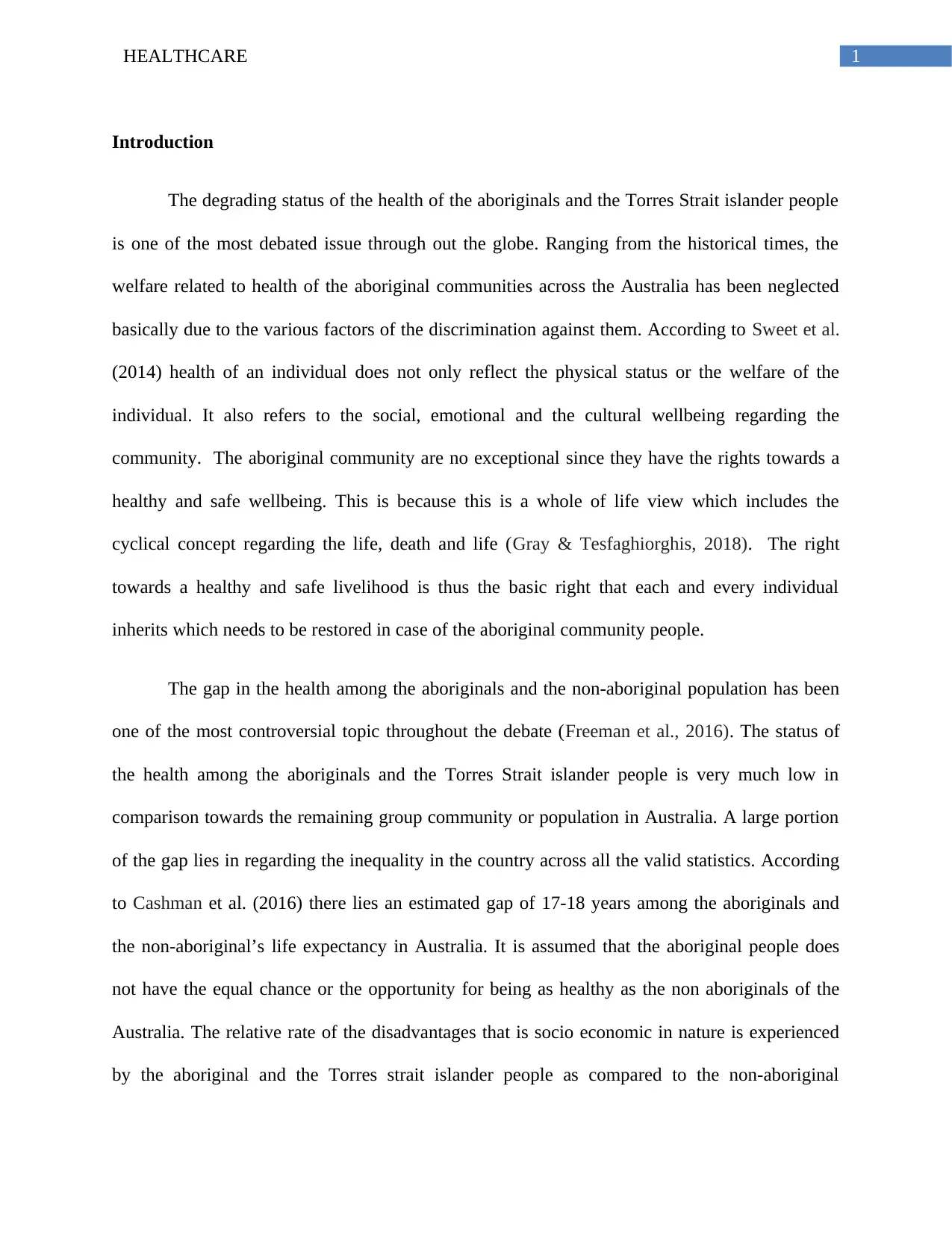
HEALTHCARE 1
Introduction
The degrading status of the health of the aboriginals and the Torres Strait islander people
is one of the most debated issue through out the globe. Ranging from the historical times, the
welfare related to health of the aboriginal communities across the Australia has been neglected
basically due to the various factors of the discrimination against them. According to Sweet et al.
(2014) health of an individual does not only reflect the physical status or the welfare of the
individual. It also refers to the social, emotional and the cultural wellbeing regarding the
community. The aboriginal community are no exceptional since they have the rights towards a
healthy and safe wellbeing. This is because this is a whole of life view which includes the
cyclical concept regarding the life, death and life (Gray & Tesfaghiorghis, 2018). The right
towards a healthy and safe livelihood is thus the basic right that each and every individual
inherits which needs to be restored in case of the aboriginal community people.
The gap in the health among the aboriginals and the non-aboriginal population has been
one of the most controversial topic throughout the debate (Freeman et al., 2016). The status of
the health among the aboriginals and the Torres Strait islander people is very much low in
comparison towards the remaining group community or population in Australia. A large portion
of the gap lies in regarding the inequality in the country across all the valid statistics. According
to Cashman et al. (2016) there lies an estimated gap of 17-18 years among the aboriginals and
the non-aboriginal’s life expectancy in Australia. It is assumed that the aboriginal people does
not have the equal chance or the opportunity for being as healthy as the non aboriginals of the
Australia. The relative rate of the disadvantages that is socio economic in nature is experienced
by the aboriginal and the Torres strait islander people as compared to the non-aboriginal
Introduction
The degrading status of the health of the aboriginals and the Torres Strait islander people
is one of the most debated issue through out the globe. Ranging from the historical times, the
welfare related to health of the aboriginal communities across the Australia has been neglected
basically due to the various factors of the discrimination against them. According to Sweet et al.
(2014) health of an individual does not only reflect the physical status or the welfare of the
individual. It also refers to the social, emotional and the cultural wellbeing regarding the
community. The aboriginal community are no exceptional since they have the rights towards a
healthy and safe wellbeing. This is because this is a whole of life view which includes the
cyclical concept regarding the life, death and life (Gray & Tesfaghiorghis, 2018). The right
towards a healthy and safe livelihood is thus the basic right that each and every individual
inherits which needs to be restored in case of the aboriginal community people.
The gap in the health among the aboriginals and the non-aboriginal population has been
one of the most controversial topic throughout the debate (Freeman et al., 2016). The status of
the health among the aboriginals and the Torres Strait islander people is very much low in
comparison towards the remaining group community or population in Australia. A large portion
of the gap lies in regarding the inequality in the country across all the valid statistics. According
to Cashman et al. (2016) there lies an estimated gap of 17-18 years among the aboriginals and
the non-aboriginal’s life expectancy in Australia. It is assumed that the aboriginal people does
not have the equal chance or the opportunity for being as healthy as the non aboriginals of the
Australia. The relative rate of the disadvantages that is socio economic in nature is experienced
by the aboriginal and the Torres strait islander people as compared to the non-aboriginal
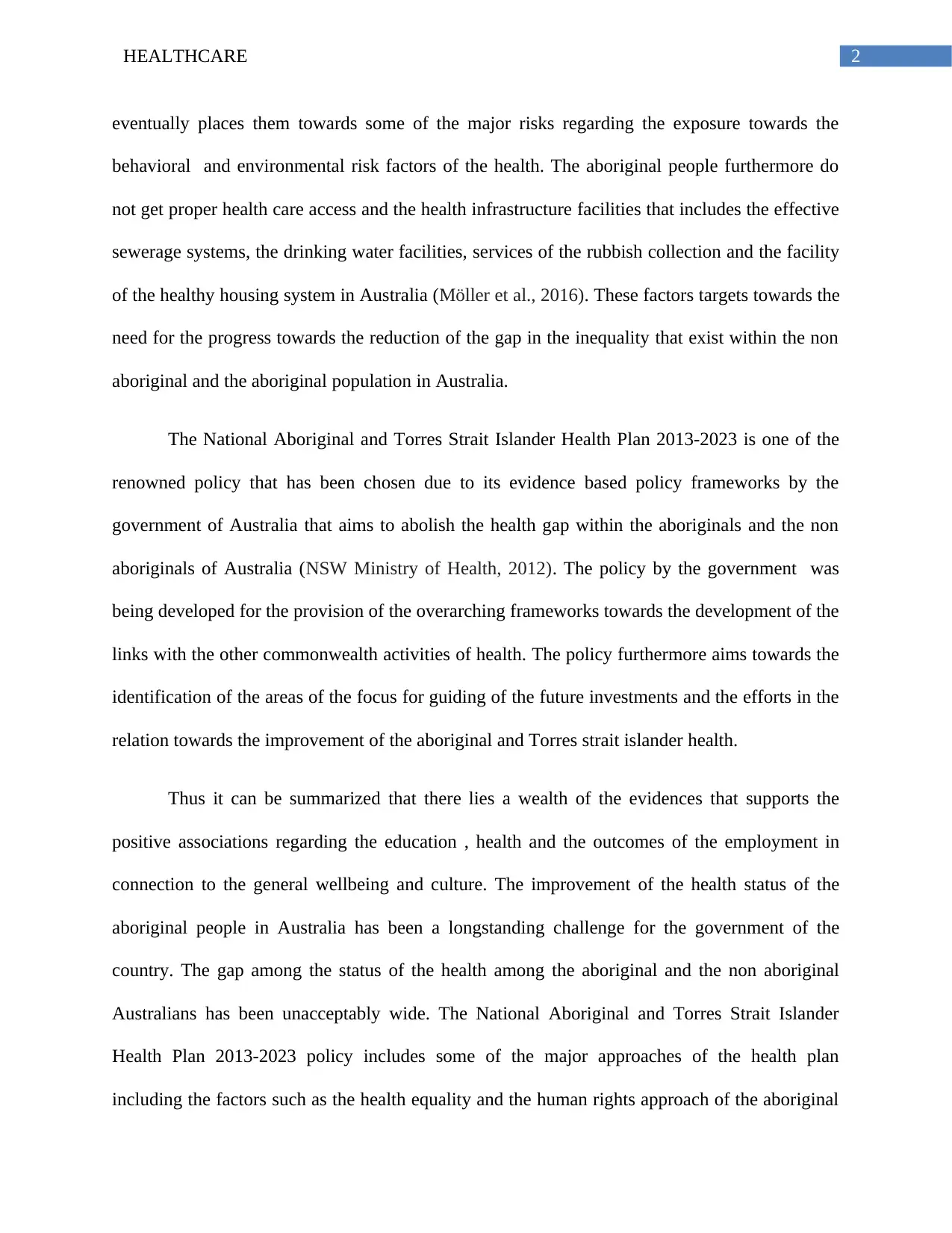
2HEALTHCARE
eventually places them towards some of the major risks regarding the exposure towards the
behavioral and environmental risk factors of the health. The aboriginal people furthermore do
not get proper health care access and the health infrastructure facilities that includes the effective
sewerage systems, the drinking water facilities, services of the rubbish collection and the facility
of the healthy housing system in Australia (Möller et al., 2016). These factors targets towards the
need for the progress towards the reduction of the gap in the inequality that exist within the non
aboriginal and the aboriginal population in Australia.
The National Aboriginal and Torres Strait Islander Health Plan 2013-2023 is one of the
renowned policy that has been chosen due to its evidence based policy frameworks by the
government of Australia that aims to abolish the health gap within the aboriginals and the non
aboriginals of Australia (NSW Ministry of Health, 2012). The policy by the government was
being developed for the provision of the overarching frameworks towards the development of the
links with the other commonwealth activities of health. The policy furthermore aims towards the
identification of the areas of the focus for guiding of the future investments and the efforts in the
relation towards the improvement of the aboriginal and Torres strait islander health.
Thus it can be summarized that there lies a wealth of the evidences that supports the
positive associations regarding the education , health and the outcomes of the employment in
connection to the general wellbeing and culture. The improvement of the health status of the
aboriginal people in Australia has been a longstanding challenge for the government of the
country. The gap among the status of the health among the aboriginal and the non aboriginal
Australians has been unacceptably wide. The National Aboriginal and Torres Strait Islander
Health Plan 2013-2023 policy includes some of the major approaches of the health plan
including the factors such as the health equality and the human rights approach of the aboriginal
eventually places them towards some of the major risks regarding the exposure towards the
behavioral and environmental risk factors of the health. The aboriginal people furthermore do
not get proper health care access and the health infrastructure facilities that includes the effective
sewerage systems, the drinking water facilities, services of the rubbish collection and the facility
of the healthy housing system in Australia (Möller et al., 2016). These factors targets towards the
need for the progress towards the reduction of the gap in the inequality that exist within the non
aboriginal and the aboriginal population in Australia.
The National Aboriginal and Torres Strait Islander Health Plan 2013-2023 is one of the
renowned policy that has been chosen due to its evidence based policy frameworks by the
government of Australia that aims to abolish the health gap within the aboriginals and the non
aboriginals of Australia (NSW Ministry of Health, 2012). The policy by the government was
being developed for the provision of the overarching frameworks towards the development of the
links with the other commonwealth activities of health. The policy furthermore aims towards the
identification of the areas of the focus for guiding of the future investments and the efforts in the
relation towards the improvement of the aboriginal and Torres strait islander health.
Thus it can be summarized that there lies a wealth of the evidences that supports the
positive associations regarding the education , health and the outcomes of the employment in
connection to the general wellbeing and culture. The improvement of the health status of the
aboriginal people in Australia has been a longstanding challenge for the government of the
country. The gap among the status of the health among the aboriginal and the non aboriginal
Australians has been unacceptably wide. The National Aboriginal and Torres Strait Islander
Health Plan 2013-2023 policy includes some of the major approaches of the health plan
including the factors such as the health equality and the human rights approach of the aboriginal
⊘ This is a preview!⊘
Do you want full access?
Subscribe today to unlock all pages.

Trusted by 1+ million students worldwide
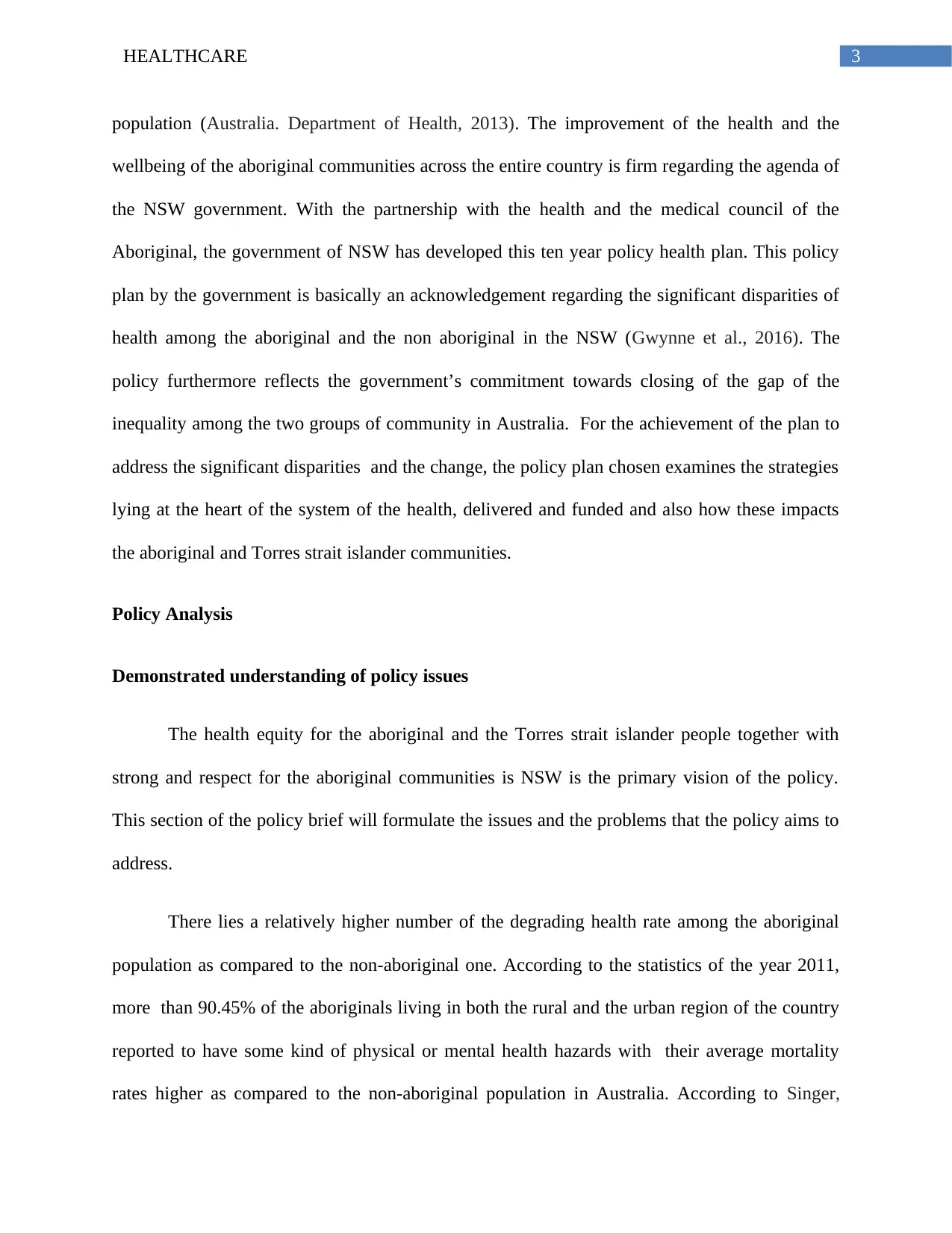
3HEALTHCARE
population (Australia. Department of Health, 2013). The improvement of the health and the
wellbeing of the aboriginal communities across the entire country is firm regarding the agenda of
the NSW government. With the partnership with the health and the medical council of the
Aboriginal, the government of NSW has developed this ten year policy health plan. This policy
plan by the government is basically an acknowledgement regarding the significant disparities of
health among the aboriginal and the non aboriginal in the NSW (Gwynne et al., 2016). The
policy furthermore reflects the government’s commitment towards closing of the gap of the
inequality among the two groups of community in Australia. For the achievement of the plan to
address the significant disparities and the change, the policy plan chosen examines the strategies
lying at the heart of the system of the health, delivered and funded and also how these impacts
the aboriginal and Torres strait islander communities.
Policy Analysis
Demonstrated understanding of policy issues
The health equity for the aboriginal and the Torres strait islander people together with
strong and respect for the aboriginal communities is NSW is the primary vision of the policy.
This section of the policy brief will formulate the issues and the problems that the policy aims to
address.
There lies a relatively higher number of the degrading health rate among the aboriginal
population as compared to the non-aboriginal one. According to the statistics of the year 2011,
more than 90.45% of the aboriginals living in both the rural and the urban region of the country
reported to have some kind of physical or mental health hazards with their average mortality
rates higher as compared to the non-aboriginal population in Australia. According to Singer,
population (Australia. Department of Health, 2013). The improvement of the health and the
wellbeing of the aboriginal communities across the entire country is firm regarding the agenda of
the NSW government. With the partnership with the health and the medical council of the
Aboriginal, the government of NSW has developed this ten year policy health plan. This policy
plan by the government is basically an acknowledgement regarding the significant disparities of
health among the aboriginal and the non aboriginal in the NSW (Gwynne et al., 2016). The
policy furthermore reflects the government’s commitment towards closing of the gap of the
inequality among the two groups of community in Australia. For the achievement of the plan to
address the significant disparities and the change, the policy plan chosen examines the strategies
lying at the heart of the system of the health, delivered and funded and also how these impacts
the aboriginal and Torres strait islander communities.
Policy Analysis
Demonstrated understanding of policy issues
The health equity for the aboriginal and the Torres strait islander people together with
strong and respect for the aboriginal communities is NSW is the primary vision of the policy.
This section of the policy brief will formulate the issues and the problems that the policy aims to
address.
There lies a relatively higher number of the degrading health rate among the aboriginal
population as compared to the non-aboriginal one. According to the statistics of the year 2011,
more than 90.45% of the aboriginals living in both the rural and the urban region of the country
reported to have some kind of physical or mental health hazards with their average mortality
rates higher as compared to the non-aboriginal population in Australia. According to Singer,
Paraphrase This Document
Need a fresh take? Get an instant paraphrase of this document with our AI Paraphraser
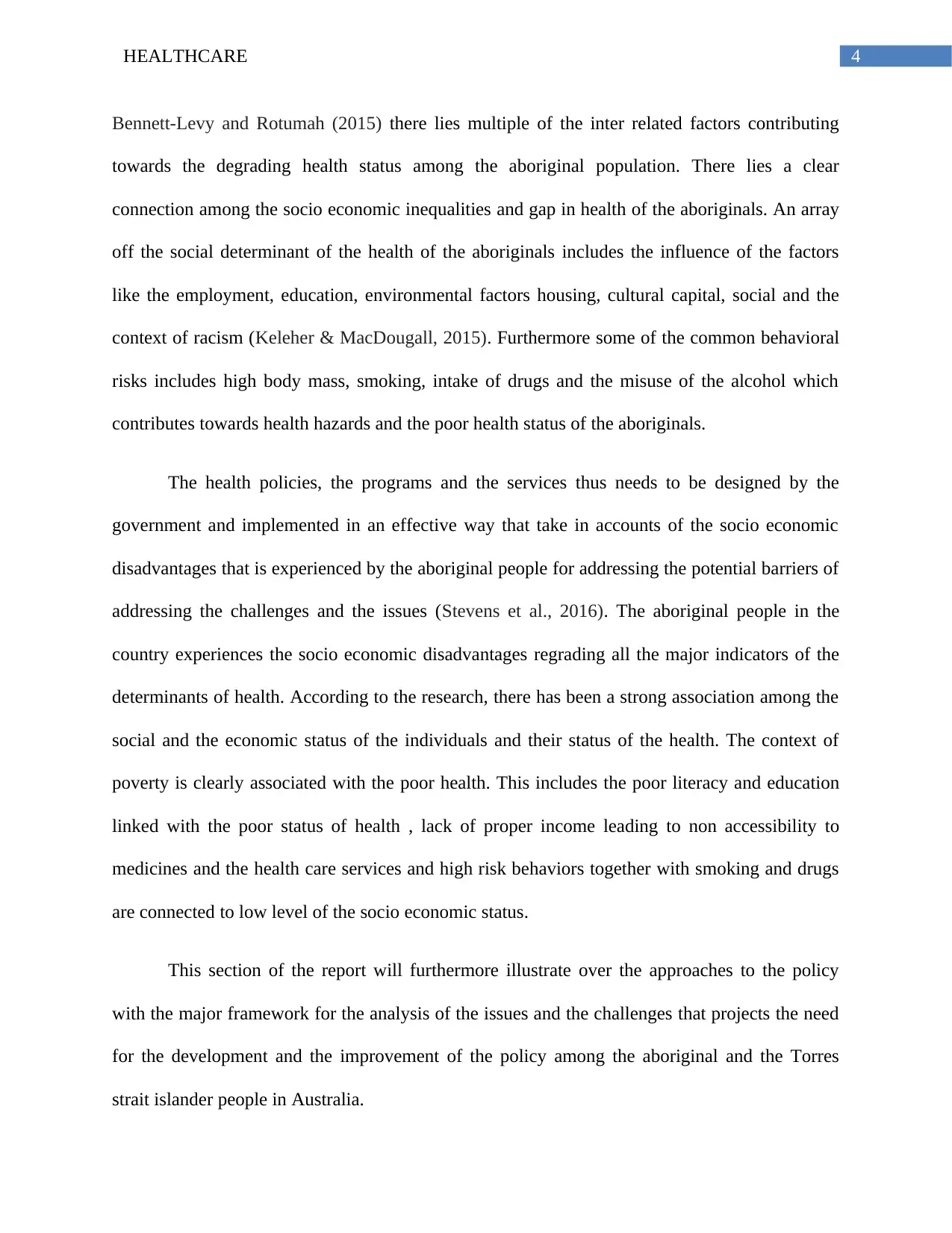
4HEALTHCARE
Bennett-Levy and Rotumah (2015) there lies multiple of the inter related factors contributing
towards the degrading health status among the aboriginal population. There lies a clear
connection among the socio economic inequalities and gap in health of the aboriginals. An array
off the social determinant of the health of the aboriginals includes the influence of the factors
like the employment, education, environmental factors housing, cultural capital, social and the
context of racism (Keleher & MacDougall, 2015). Furthermore some of the common behavioral
risks includes high body mass, smoking, intake of drugs and the misuse of the alcohol which
contributes towards health hazards and the poor health status of the aboriginals.
The health policies, the programs and the services thus needs to be designed by the
government and implemented in an effective way that take in accounts of the socio economic
disadvantages that is experienced by the aboriginal people for addressing the potential barriers of
addressing the challenges and the issues (Stevens et al., 2016). The aboriginal people in the
country experiences the socio economic disadvantages regrading all the major indicators of the
determinants of health. According to the research, there has been a strong association among the
social and the economic status of the individuals and their status of the health. The context of
poverty is clearly associated with the poor health. This includes the poor literacy and education
linked with the poor status of health , lack of proper income leading to non accessibility to
medicines and the health care services and high risk behaviors together with smoking and drugs
are connected to low level of the socio economic status.
This section of the report will furthermore illustrate over the approaches to the policy
with the major framework for the analysis of the issues and the challenges that projects the need
for the development and the improvement of the policy among the aboriginal and the Torres
strait islander people in Australia.
Bennett-Levy and Rotumah (2015) there lies multiple of the inter related factors contributing
towards the degrading health status among the aboriginal population. There lies a clear
connection among the socio economic inequalities and gap in health of the aboriginals. An array
off the social determinant of the health of the aboriginals includes the influence of the factors
like the employment, education, environmental factors housing, cultural capital, social and the
context of racism (Keleher & MacDougall, 2015). Furthermore some of the common behavioral
risks includes high body mass, smoking, intake of drugs and the misuse of the alcohol which
contributes towards health hazards and the poor health status of the aboriginals.
The health policies, the programs and the services thus needs to be designed by the
government and implemented in an effective way that take in accounts of the socio economic
disadvantages that is experienced by the aboriginal people for addressing the potential barriers of
addressing the challenges and the issues (Stevens et al., 2016). The aboriginal people in the
country experiences the socio economic disadvantages regrading all the major indicators of the
determinants of health. According to the research, there has been a strong association among the
social and the economic status of the individuals and their status of the health. The context of
poverty is clearly associated with the poor health. This includes the poor literacy and education
linked with the poor status of health , lack of proper income leading to non accessibility to
medicines and the health care services and high risk behaviors together with smoking and drugs
are connected to low level of the socio economic status.
This section of the report will furthermore illustrate over the approaches to the policy
with the major framework for the analysis of the issues and the challenges that projects the need
for the development and the improvement of the policy among the aboriginal and the Torres
strait islander people in Australia.
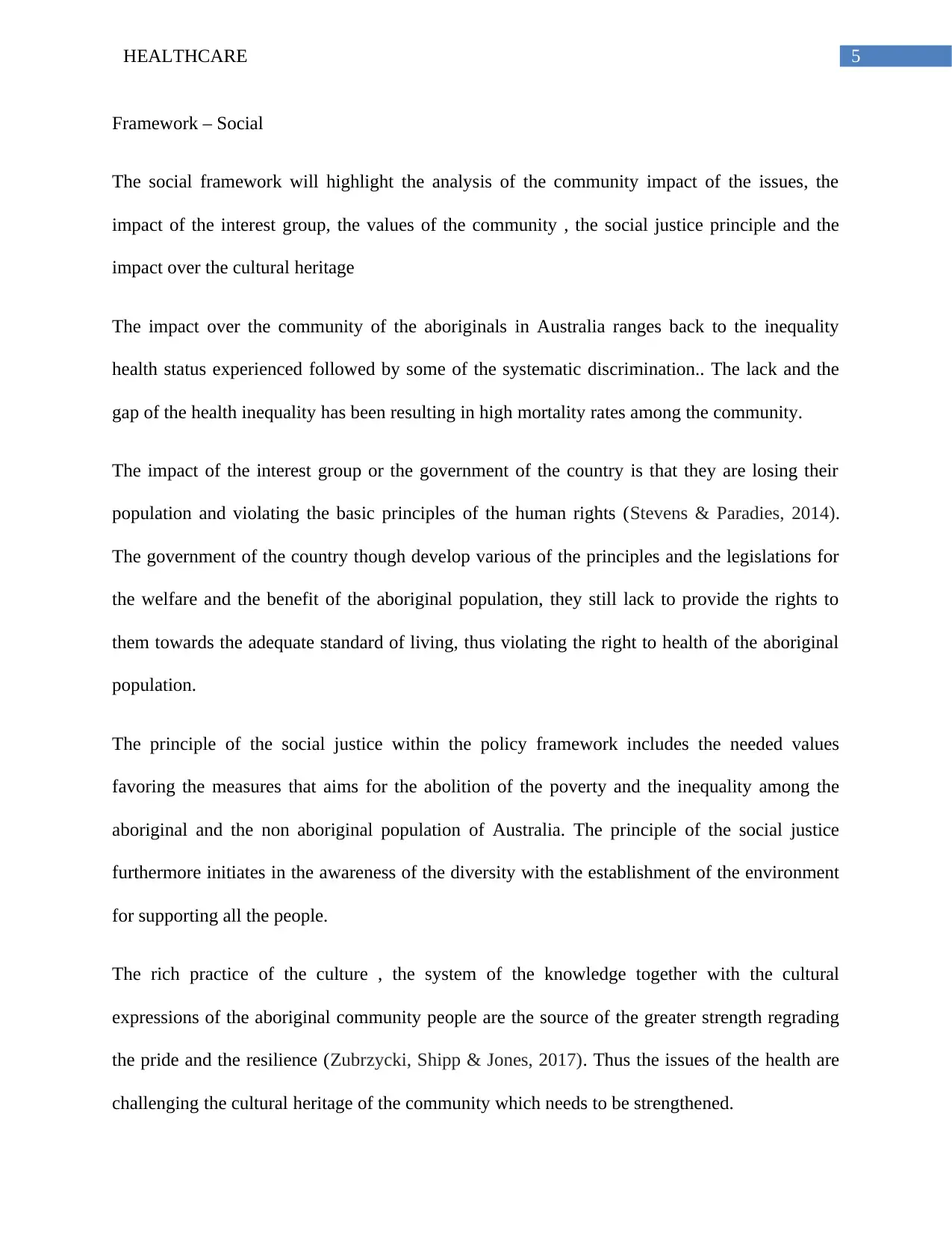
5HEALTHCARE
Framework – Social
The social framework will highlight the analysis of the community impact of the issues, the
impact of the interest group, the values of the community , the social justice principle and the
impact over the cultural heritage
The impact over the community of the aboriginals in Australia ranges back to the inequality
health status experienced followed by some of the systematic discrimination.. The lack and the
gap of the health inequality has been resulting in high mortality rates among the community.
The impact of the interest group or the government of the country is that they are losing their
population and violating the basic principles of the human rights (Stevens & Paradies, 2014).
The government of the country though develop various of the principles and the legislations for
the welfare and the benefit of the aboriginal population, they still lack to provide the rights to
them towards the adequate standard of living, thus violating the right to health of the aboriginal
population.
The principle of the social justice within the policy framework includes the needed values
favoring the measures that aims for the abolition of the poverty and the inequality among the
aboriginal and the non aboriginal population of Australia. The principle of the social justice
furthermore initiates in the awareness of the diversity with the establishment of the environment
for supporting all the people.
The rich practice of the culture , the system of the knowledge together with the cultural
expressions of the aboriginal community people are the source of the greater strength regrading
the pride and the resilience (Zubrzycki, Shipp & Jones, 2017). Thus the issues of the health are
challenging the cultural heritage of the community which needs to be strengthened.
Framework – Social
The social framework will highlight the analysis of the community impact of the issues, the
impact of the interest group, the values of the community , the social justice principle and the
impact over the cultural heritage
The impact over the community of the aboriginals in Australia ranges back to the inequality
health status experienced followed by some of the systematic discrimination.. The lack and the
gap of the health inequality has been resulting in high mortality rates among the community.
The impact of the interest group or the government of the country is that they are losing their
population and violating the basic principles of the human rights (Stevens & Paradies, 2014).
The government of the country though develop various of the principles and the legislations for
the welfare and the benefit of the aboriginal population, they still lack to provide the rights to
them towards the adequate standard of living, thus violating the right to health of the aboriginal
population.
The principle of the social justice within the policy framework includes the needed values
favoring the measures that aims for the abolition of the poverty and the inequality among the
aboriginal and the non aboriginal population of Australia. The principle of the social justice
furthermore initiates in the awareness of the diversity with the establishment of the environment
for supporting all the people.
The rich practice of the culture , the system of the knowledge together with the cultural
expressions of the aboriginal community people are the source of the greater strength regrading
the pride and the resilience (Zubrzycki, Shipp & Jones, 2017). Thus the issues of the health are
challenging the cultural heritage of the community which needs to be strengthened.
⊘ This is a preview!⊘
Do you want full access?
Subscribe today to unlock all pages.

Trusted by 1+ million students worldwide
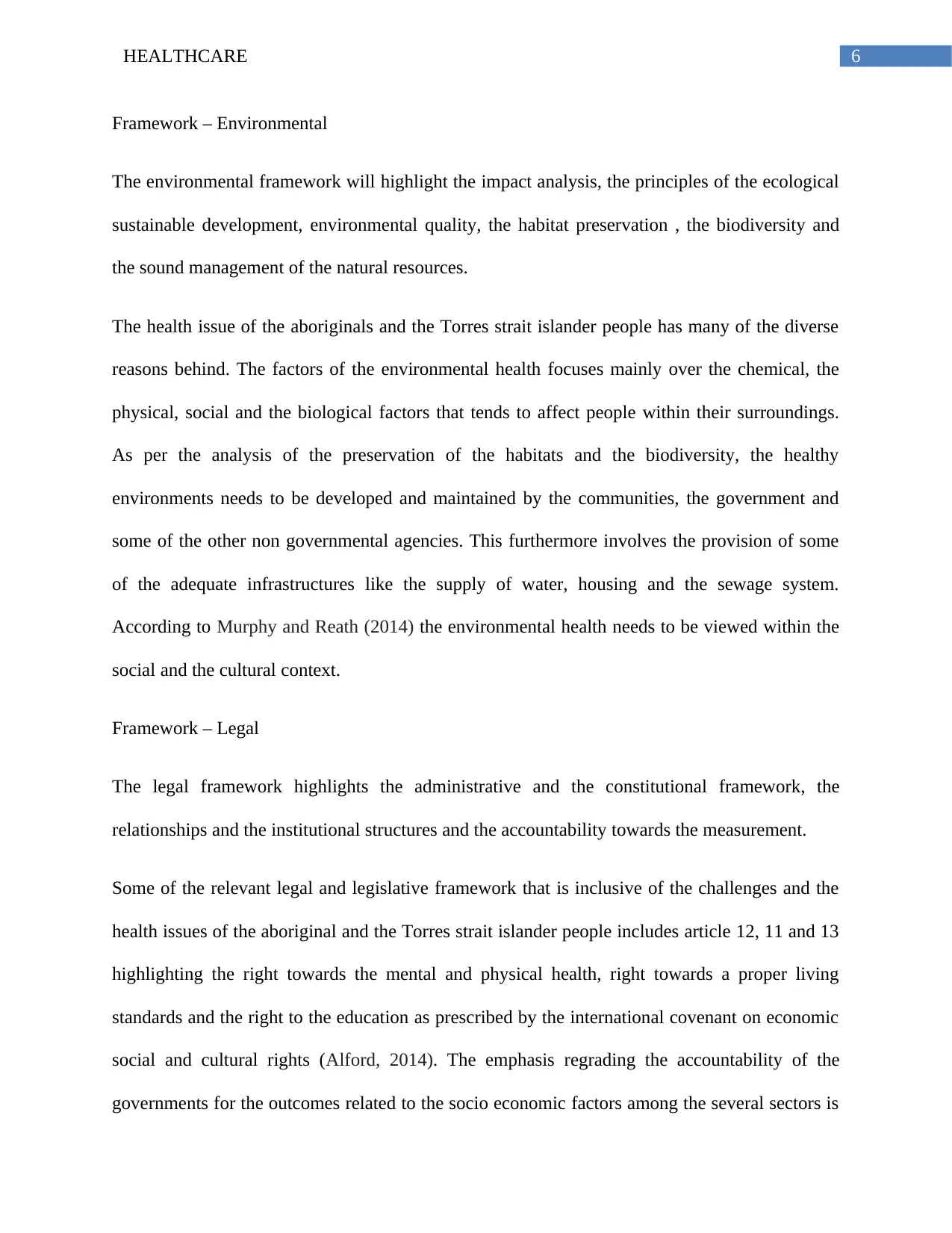
6HEALTHCARE
Framework – Environmental
The environmental framework will highlight the impact analysis, the principles of the ecological
sustainable development, environmental quality, the habitat preservation , the biodiversity and
the sound management of the natural resources.
The health issue of the aboriginals and the Torres strait islander people has many of the diverse
reasons behind. The factors of the environmental health focuses mainly over the chemical, the
physical, social and the biological factors that tends to affect people within their surroundings.
As per the analysis of the preservation of the habitats and the biodiversity, the healthy
environments needs to be developed and maintained by the communities, the government and
some of the other non governmental agencies. This furthermore involves the provision of some
of the adequate infrastructures like the supply of water, housing and the sewage system.
According to Murphy and Reath (2014) the environmental health needs to be viewed within the
social and the cultural context.
Framework – Legal
The legal framework highlights the administrative and the constitutional framework, the
relationships and the institutional structures and the accountability towards the measurement.
Some of the relevant legal and legislative framework that is inclusive of the challenges and the
health issues of the aboriginal and the Torres strait islander people includes article 12, 11 and 13
highlighting the right towards the mental and physical health, right towards a proper living
standards and the right to the education as prescribed by the international covenant on economic
social and cultural rights (Alford, 2014). The emphasis regrading the accountability of the
governments for the outcomes related to the socio economic factors among the several sectors is
Framework – Environmental
The environmental framework will highlight the impact analysis, the principles of the ecological
sustainable development, environmental quality, the habitat preservation , the biodiversity and
the sound management of the natural resources.
The health issue of the aboriginals and the Torres strait islander people has many of the diverse
reasons behind. The factors of the environmental health focuses mainly over the chemical, the
physical, social and the biological factors that tends to affect people within their surroundings.
As per the analysis of the preservation of the habitats and the biodiversity, the healthy
environments needs to be developed and maintained by the communities, the government and
some of the other non governmental agencies. This furthermore involves the provision of some
of the adequate infrastructures like the supply of water, housing and the sewage system.
According to Murphy and Reath (2014) the environmental health needs to be viewed within the
social and the cultural context.
Framework – Legal
The legal framework highlights the administrative and the constitutional framework, the
relationships and the institutional structures and the accountability towards the measurement.
Some of the relevant legal and legislative framework that is inclusive of the challenges and the
health issues of the aboriginal and the Torres strait islander people includes article 12, 11 and 13
highlighting the right towards the mental and physical health, right towards a proper living
standards and the right to the education as prescribed by the international covenant on economic
social and cultural rights (Alford, 2014). The emphasis regrading the accountability of the
governments for the outcomes related to the socio economic factors among the several sectors is
Paraphrase This Document
Need a fresh take? Get an instant paraphrase of this document with our AI Paraphraser
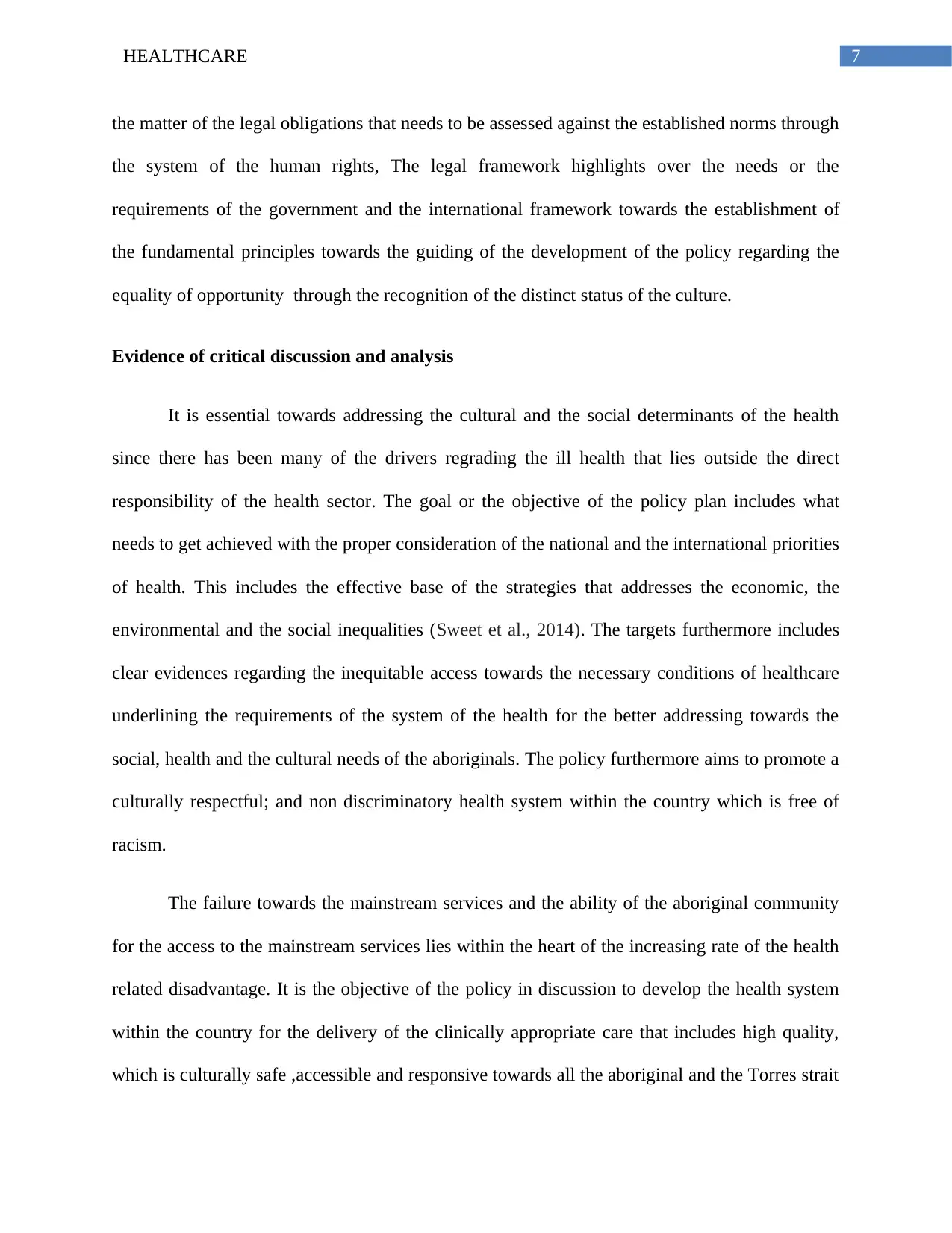
7HEALTHCARE
the matter of the legal obligations that needs to be assessed against the established norms through
the system of the human rights, The legal framework highlights over the needs or the
requirements of the government and the international framework towards the establishment of
the fundamental principles towards the guiding of the development of the policy regarding the
equality of opportunity through the recognition of the distinct status of the culture.
Evidence of critical discussion and analysis
It is essential towards addressing the cultural and the social determinants of the health
since there has been many of the drivers regrading the ill health that lies outside the direct
responsibility of the health sector. The goal or the objective of the policy plan includes what
needs to get achieved with the proper consideration of the national and the international priorities
of health. This includes the effective base of the strategies that addresses the economic, the
environmental and the social inequalities (Sweet et al., 2014). The targets furthermore includes
clear evidences regarding the inequitable access towards the necessary conditions of healthcare
underlining the requirements of the system of the health for the better addressing towards the
social, health and the cultural needs of the aboriginals. The policy furthermore aims to promote a
culturally respectful; and non discriminatory health system within the country which is free of
racism.
The failure towards the mainstream services and the ability of the aboriginal community
for the access to the mainstream services lies within the heart of the increasing rate of the health
related disadvantage. It is the objective of the policy in discussion to develop the health system
within the country for the delivery of the clinically appropriate care that includes high quality,
which is culturally safe ,accessible and responsive towards all the aboriginal and the Torres strait
the matter of the legal obligations that needs to be assessed against the established norms through
the system of the human rights, The legal framework highlights over the needs or the
requirements of the government and the international framework towards the establishment of
the fundamental principles towards the guiding of the development of the policy regarding the
equality of opportunity through the recognition of the distinct status of the culture.
Evidence of critical discussion and analysis
It is essential towards addressing the cultural and the social determinants of the health
since there has been many of the drivers regrading the ill health that lies outside the direct
responsibility of the health sector. The goal or the objective of the policy plan includes what
needs to get achieved with the proper consideration of the national and the international priorities
of health. This includes the effective base of the strategies that addresses the economic, the
environmental and the social inequalities (Sweet et al., 2014). The targets furthermore includes
clear evidences regarding the inequitable access towards the necessary conditions of healthcare
underlining the requirements of the system of the health for the better addressing towards the
social, health and the cultural needs of the aboriginals. The policy furthermore aims to promote a
culturally respectful; and non discriminatory health system within the country which is free of
racism.
The failure towards the mainstream services and the ability of the aboriginal community
for the access to the mainstream services lies within the heart of the increasing rate of the health
related disadvantage. It is the objective of the policy in discussion to develop the health system
within the country for the delivery of the clinically appropriate care that includes high quality,
which is culturally safe ,accessible and responsive towards all the aboriginal and the Torres strait
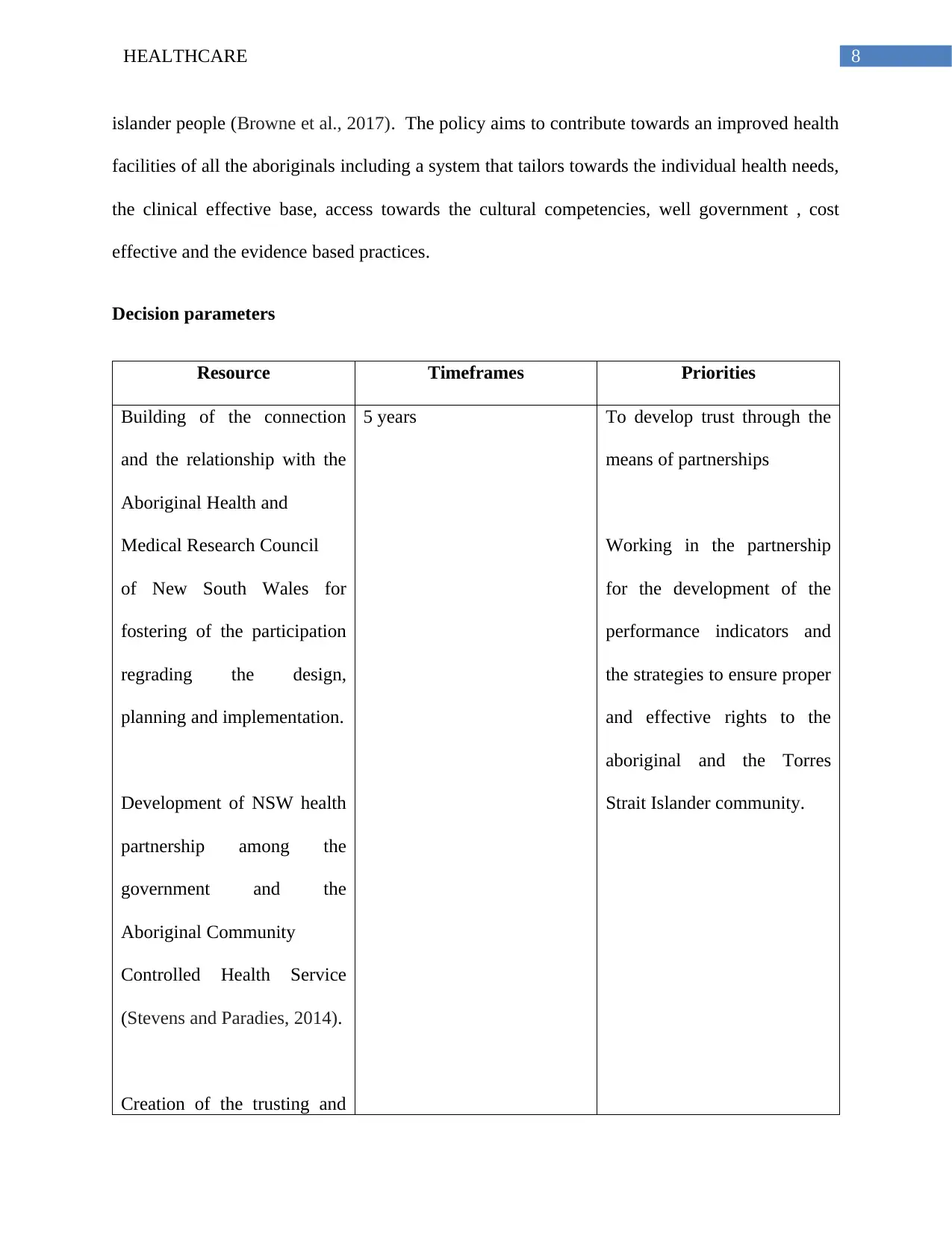
8HEALTHCARE
islander people (Browne et al., 2017). The policy aims to contribute towards an improved health
facilities of all the aboriginals including a system that tailors towards the individual health needs,
the clinical effective base, access towards the cultural competencies, well government , cost
effective and the evidence based practices.
Decision parameters
Resource Timeframes Priorities
Building of the connection
and the relationship with the
Aboriginal Health and
Medical Research Council
of New South Wales for
fostering of the participation
regrading the design,
planning and implementation.
Development of NSW health
partnership among the
government and the
Aboriginal Community
Controlled Health Service
(Stevens and Paradies, 2014).
Creation of the trusting and
5 years To develop trust through the
means of partnerships
Working in the partnership
for the development of the
performance indicators and
the strategies to ensure proper
and effective rights to the
aboriginal and the Torres
Strait Islander community.
islander people (Browne et al., 2017). The policy aims to contribute towards an improved health
facilities of all the aboriginals including a system that tailors towards the individual health needs,
the clinical effective base, access towards the cultural competencies, well government , cost
effective and the evidence based practices.
Decision parameters
Resource Timeframes Priorities
Building of the connection
and the relationship with the
Aboriginal Health and
Medical Research Council
of New South Wales for
fostering of the participation
regrading the design,
planning and implementation.
Development of NSW health
partnership among the
government and the
Aboriginal Community
Controlled Health Service
(Stevens and Paradies, 2014).
Creation of the trusting and
5 years To develop trust through the
means of partnerships
Working in the partnership
for the development of the
performance indicators and
the strategies to ensure proper
and effective rights to the
aboriginal and the Torres
Strait Islander community.
⊘ This is a preview!⊘
Do you want full access?
Subscribe today to unlock all pages.

Trusted by 1+ million students worldwide
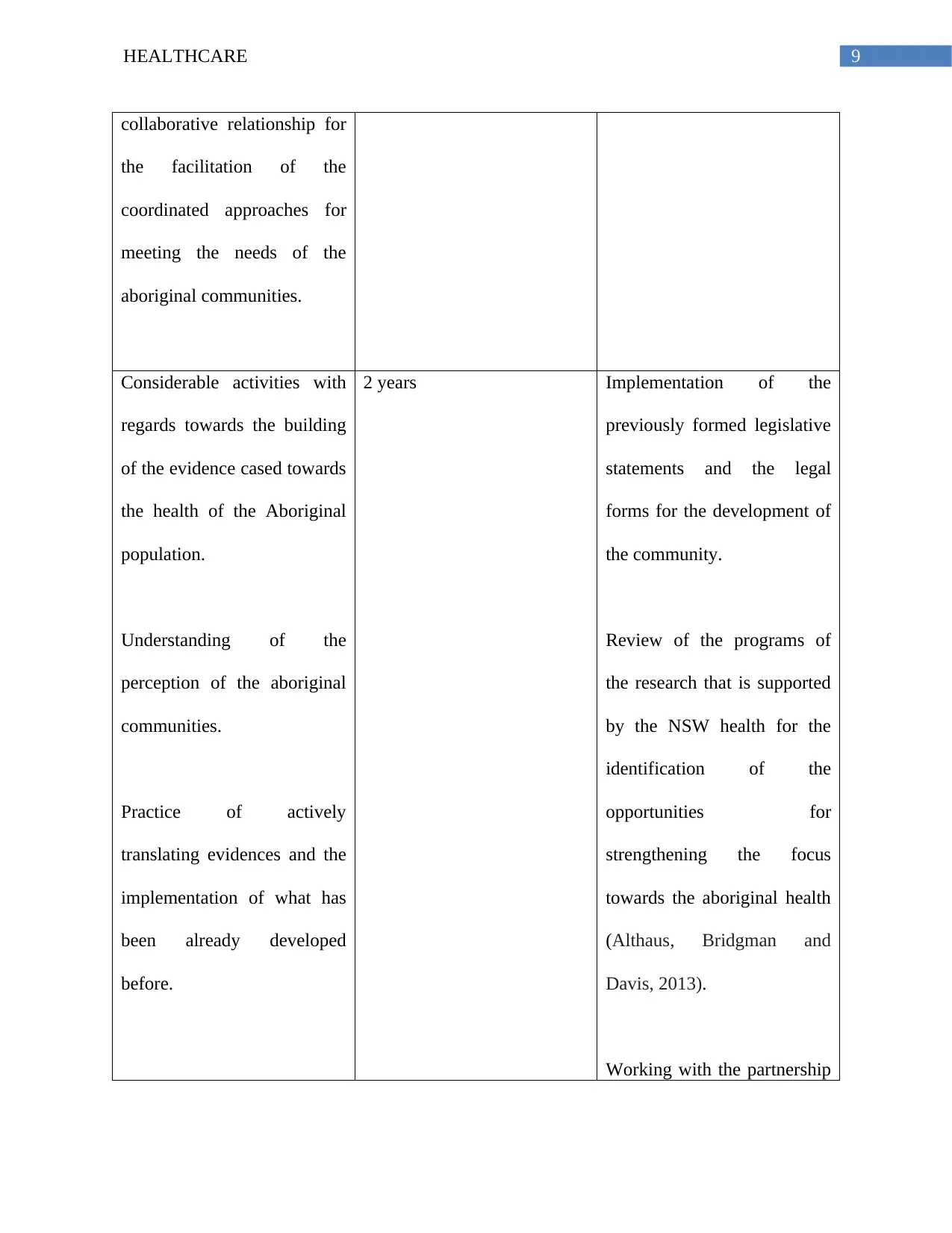
9HEALTHCARE
collaborative relationship for
the facilitation of the
coordinated approaches for
meeting the needs of the
aboriginal communities.
Considerable activities with
regards towards the building
of the evidence cased towards
the health of the Aboriginal
population.
Understanding of the
perception of the aboriginal
communities.
Practice of actively
translating evidences and the
implementation of what has
been already developed
before.
2 years Implementation of the
previously formed legislative
statements and the legal
forms for the development of
the community.
Review of the programs of
the research that is supported
by the NSW health for the
identification of the
opportunities for
strengthening the focus
towards the aboriginal health
(Althaus, Bridgman and
Davis, 2013).
Working with the partnership
collaborative relationship for
the facilitation of the
coordinated approaches for
meeting the needs of the
aboriginal communities.
Considerable activities with
regards towards the building
of the evidence cased towards
the health of the Aboriginal
population.
Understanding of the
perception of the aboriginal
communities.
Practice of actively
translating evidences and the
implementation of what has
been already developed
before.
2 years Implementation of the
previously formed legislative
statements and the legal
forms for the development of
the community.
Review of the programs of
the research that is supported
by the NSW health for the
identification of the
opportunities for
strengthening the focus
towards the aboriginal health
(Althaus, Bridgman and
Davis, 2013).
Working with the partnership
Paraphrase This Document
Need a fresh take? Get an instant paraphrase of this document with our AI Paraphraser
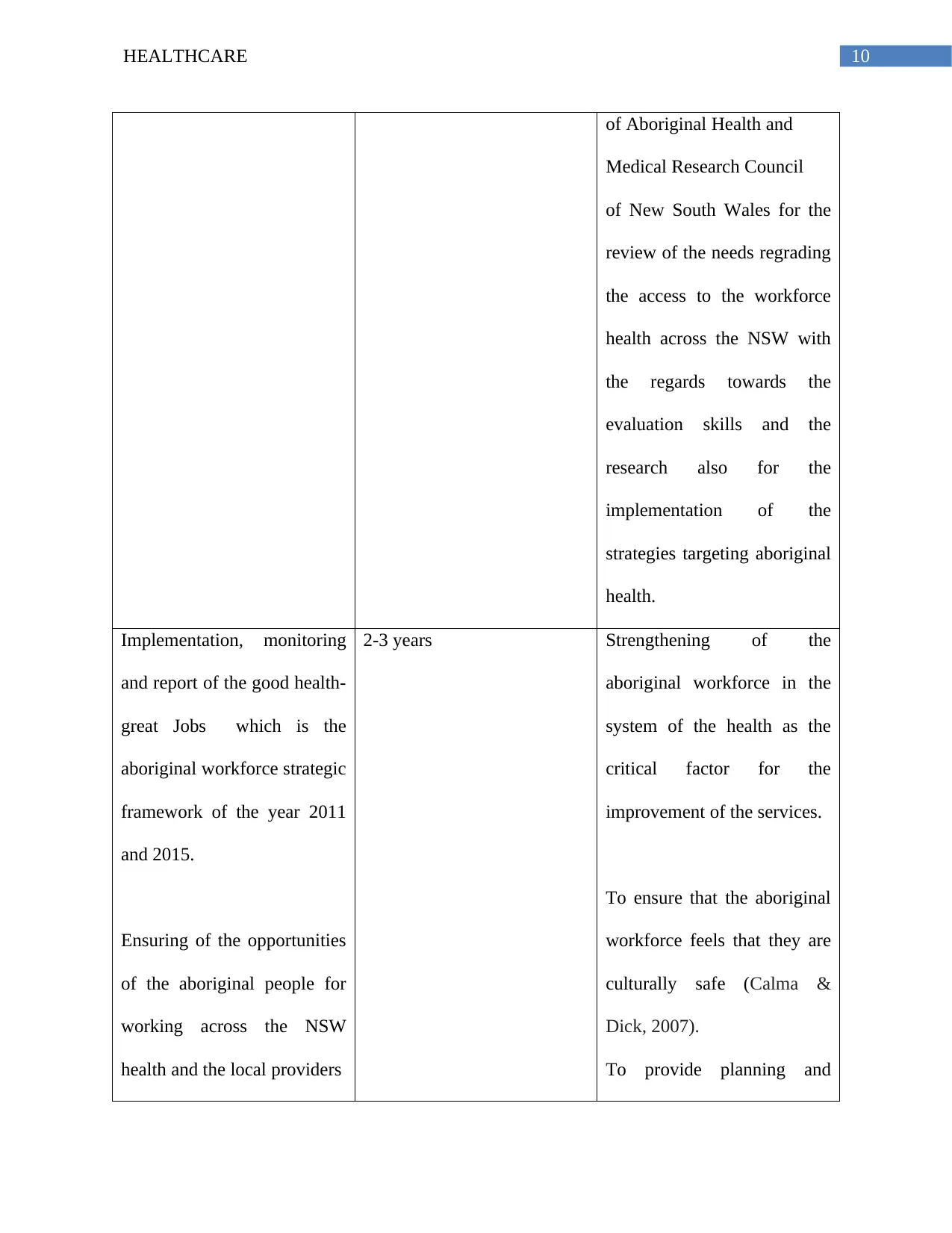
10HEALTHCARE
of Aboriginal Health and
Medical Research Council
of New South Wales for the
review of the needs regrading
the access to the workforce
health across the NSW with
the regards towards the
evaluation skills and the
research also for the
implementation of the
strategies targeting aboriginal
health.
Implementation, monitoring
and report of the good health-
great Jobs which is the
aboriginal workforce strategic
framework of the year 2011
and 2015.
Ensuring of the opportunities
of the aboriginal people for
working across the NSW
health and the local providers
2-3 years Strengthening of the
aboriginal workforce in the
system of the health as the
critical factor for the
improvement of the services.
To ensure that the aboriginal
workforce feels that they are
culturally safe (Calma &
Dick, 2007).
To provide planning and
of Aboriginal Health and
Medical Research Council
of New South Wales for the
review of the needs regrading
the access to the workforce
health across the NSW with
the regards towards the
evaluation skills and the
research also for the
implementation of the
strategies targeting aboriginal
health.
Implementation, monitoring
and report of the good health-
great Jobs which is the
aboriginal workforce strategic
framework of the year 2011
and 2015.
Ensuring of the opportunities
of the aboriginal people for
working across the NSW
health and the local providers
2-3 years Strengthening of the
aboriginal workforce in the
system of the health as the
critical factor for the
improvement of the services.
To ensure that the aboriginal
workforce feels that they are
culturally safe (Calma &
Dick, 2007).
To provide planning and
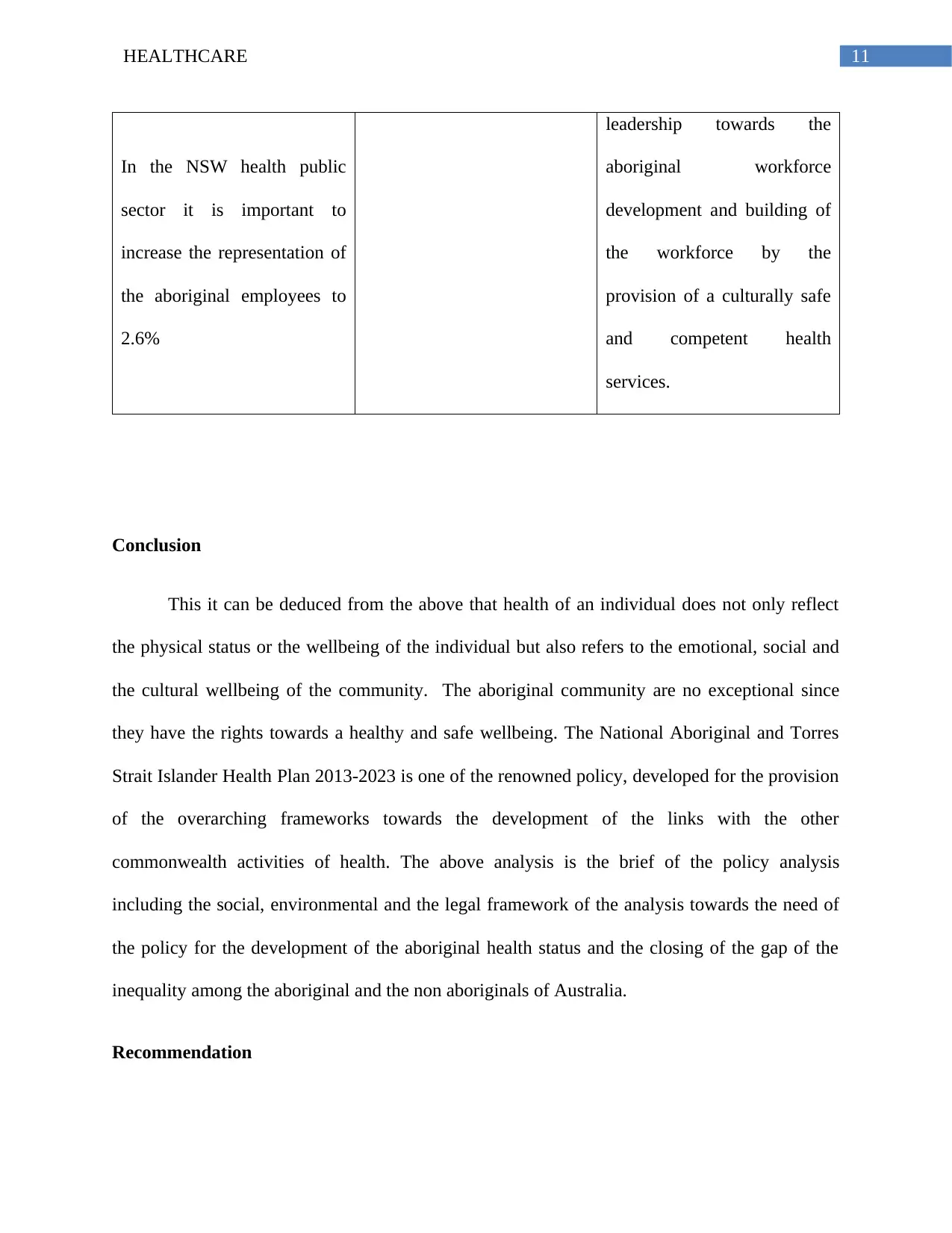
11HEALTHCARE
In the NSW health public
sector it is important to
increase the representation of
the aboriginal employees to
2.6%
leadership towards the
aboriginal workforce
development and building of
the workforce by the
provision of a culturally safe
and competent health
services.
Conclusion
This it can be deduced from the above that health of an individual does not only reflect
the physical status or the wellbeing of the individual but also refers to the emotional, social and
the cultural wellbeing of the community. The aboriginal community are no exceptional since
they have the rights towards a healthy and safe wellbeing. The National Aboriginal and Torres
Strait Islander Health Plan 2013-2023 is one of the renowned policy, developed for the provision
of the overarching frameworks towards the development of the links with the other
commonwealth activities of health. The above analysis is the brief of the policy analysis
including the social, environmental and the legal framework of the analysis towards the need of
the policy for the development of the aboriginal health status and the closing of the gap of the
inequality among the aboriginal and the non aboriginals of Australia.
Recommendation
In the NSW health public
sector it is important to
increase the representation of
the aboriginal employees to
2.6%
leadership towards the
aboriginal workforce
development and building of
the workforce by the
provision of a culturally safe
and competent health
services.
Conclusion
This it can be deduced from the above that health of an individual does not only reflect
the physical status or the wellbeing of the individual but also refers to the emotional, social and
the cultural wellbeing of the community. The aboriginal community are no exceptional since
they have the rights towards a healthy and safe wellbeing. The National Aboriginal and Torres
Strait Islander Health Plan 2013-2023 is one of the renowned policy, developed for the provision
of the overarching frameworks towards the development of the links with the other
commonwealth activities of health. The above analysis is the brief of the policy analysis
including the social, environmental and the legal framework of the analysis towards the need of
the policy for the development of the aboriginal health status and the closing of the gap of the
inequality among the aboriginal and the non aboriginals of Australia.
Recommendation
⊘ This is a preview!⊘
Do you want full access?
Subscribe today to unlock all pages.

Trusted by 1+ million students worldwide
1 out of 16
Related Documents
Your All-in-One AI-Powered Toolkit for Academic Success.
+13062052269
info@desklib.com
Available 24*7 on WhatsApp / Email
![[object Object]](/_next/static/media/star-bottom.7253800d.svg)
Unlock your academic potential
Copyright © 2020–2025 A2Z Services. All Rights Reserved. Developed and managed by ZUCOL.





